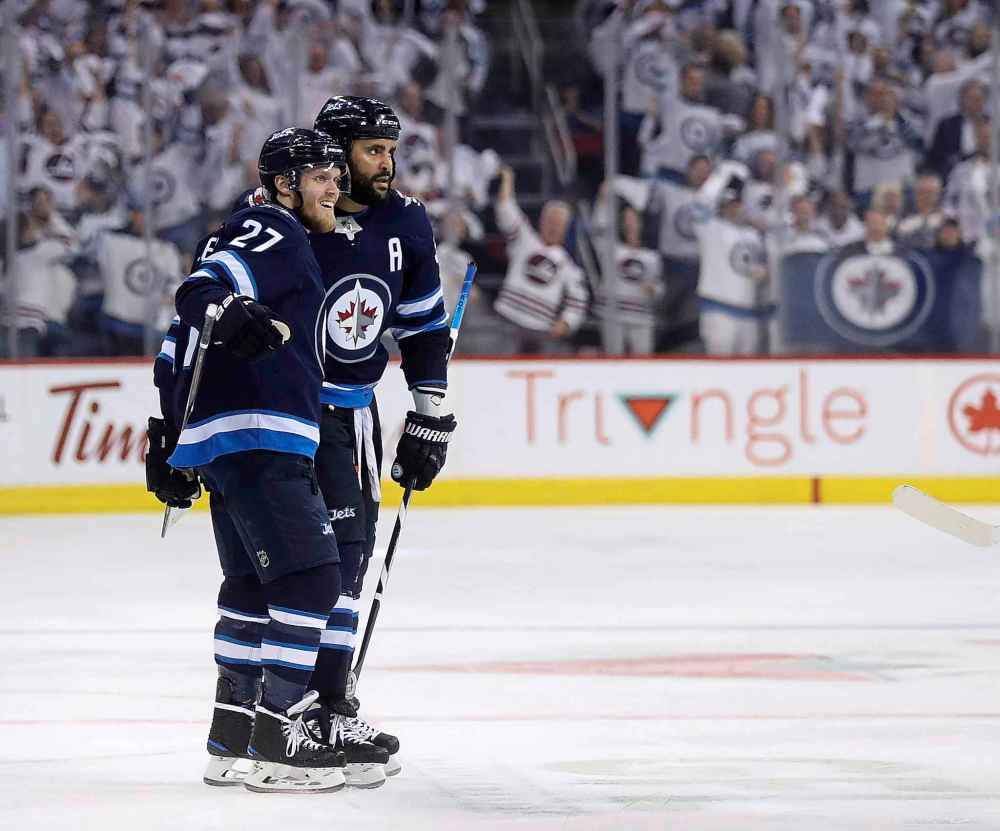Scoring talent keeping Jets aloft despite defensive leaks
Read this article for free:
or
Already have an account? Log in here »
To continue reading, please subscribe:
Monthly Digital Subscription
$0 for the first 4 weeks*
- Enjoy unlimited reading on winnipegfreepress.com
- Read the E-Edition, our digital replica newspaper
- Access News Break, our award-winning app
- Play interactive puzzles
*No charge for 4 weeks then price increases to the regular rate of $19.00 plus GST every four weeks. Offer available to new and qualified returning subscribers only. Cancel any time.
Monthly Digital Subscription
$4.75/week*
- Enjoy unlimited reading on winnipegfreepress.com
- Read the E-Edition, our digital replica newspaper
- Access News Break, our award-winning app
- Play interactive puzzles
*Billed as $19 plus GST every four weeks. Cancel any time.
To continue reading, please subscribe:
Add Free Press access to your Brandon Sun subscription for only an additional
$1 for the first 4 weeks*
*Your next subscription payment will increase by $1.00 and you will be charged $16.99 plus GST for four weeks. After four weeks, your payment will increase to $23.99 plus GST every four weeks.
Read unlimited articles for free today:
or
Already have an account? Log in here »
Hey there, time traveller!
This article was published 08/01/2019 (2530 days ago), so information in it may no longer be current.
We’re halfway through the 2018-19 season, and the Winnipeg Jets are about where everyone expected them to be; battling for the top spot in the Central Division with the Nashville Predators.
The Jets have games in hand on the Predators, and have made up some ground on their division rivals while Nashville was inundated with injuries over the second quarter of the season.
The Jets, meanwhile, are dealing with their own injury troubles with both Dustin Byfuglien and Nikolaj Ehlers on injury reserve; neither is expected back before the beginning of February at the earliest.

Injuries are a part of the game that all teams battle through, and the Jets of last season were no different, losing Scheifele and Byfuglien for stretches only to rally and get even better in time for the playoffs.
This season the Jets have been mostly healthy so far, and yet I don’t think I’m alone in thinking that they haven’t really clicked fully yet for long stretches. They’re a good team — there’s no doubt about that — but the clear Stanley Cup contenders of last season have yet to show up, despite the fact that the team is on pace for only six fewer points than last season’s stellar 114.
Despite not having hit their peak, the Jets are doing some things correctly, and while they look a little less impressive on the surface than last year’s edition, maybe we’re missing something. Let’s compare the first half of this season to last season to see how much change there’s really been.
In order to get the most detail possible, we’re going to separate offence and defence instead of just posting differentials, so we’ll look at the rates at which the Jets create and prevent scoring plays.
!function(e,t,s,i){var n=”InfogramEmbeds”,o=e.getElementsByTagName(“script”)[0],d=/^http:/.test(e.location)?”http:”:”https:”;if(/^/{2}/.test(i)&&(i=d+i),window[n]&&window[n].initialized)window[n].process&&window[n].process();else if(!e.getElementById(s)){var r=e.createElement(“script”);r.async=1,r.id=s,r.src=i,o.parentNode.insertBefore(r,o)}}(document,0,”infogram-async”,”https://e.infogram.com/js/dist/embed-loader-min.js”);
Overall, there hasn’t been a huge amount of change for the Jets’ offence from last season to this season, as they’re still a team that thrives on passing plays. They are moving the puck laterally in the offensive zone with east-west passes slightly less often than they did last year, while making slightly more completed passes off the rush, which I think is mostly a big step forward for Ehlers.
In terms of scoring chances, the Jets are shooting from better areas overall, getting closer to the net and their chances are a bit more dangerous. The forwards are less reliant on forechecking to get good scoring opportunities, creating a bit more off the rush and off the cycle, resulting in a slight increase in scoring chances, on the whole.
While there are no big, drastic changes here, I think we can reasonably conclude that at even-strength, the Jets have been slightly more dangerous than they were last year, which could help to explain their strong place in the standings.
On the other side of the puck, things look much less rosy, and while the Jets were one of the NHL’s premier teams defensively last season, that has not been the case thus far.
!function(e,t,s,i){var n=”InfogramEmbeds”,o=e.getElementsByTagName(“script”)[0],d=/^http:/.test(e.location)?”http:”:”https:”;if(/^/{2}/.test(i)&&(i=d+i),window[n]&&window[n].initialized)window[n].process&&window[n].process();else if(!e.getElementById(s)){var r=e.createElement(“script”);r.async=1,r.id=s,r.src=i,o.parentNode.insertBefore(r,o)}}(document,0,”infogram-async”,”https://e.infogram.com/js/dist/embed-loader-min.js”);
In terms of preventing the opposition from moving the puck in their own zone, the Jets remain quite strong, with slight increases in passes to the slot and east-west passes allowed, and a slight decrease in passes off the rush. All together, they are still a top-10 team in pass suppression, which is the good news.
The bad news is that the Jets have been far more porous in their shot coverage this year than in recent seasons, especially compared to last year. They’re allowing more scoring chances-against of every type, both in the inner slot or high-danger area and the high slot.
Combine that information with the slight uptick in dangerous passes allowed, and it’s no wonder why Connor Hellebuyck’s save percentage has been such a disappointment for many this season. It’s also worth noting that the Jets are allowing about two fewer perimeter shots against per game, shots that can boost goalie numbers a bit, which further amplifies Hellebuyck’s perceived struggles on paper.

Obviously, there were a few changes to the roster in the off-season, most of them very minor, but I’m just throwing an idea out there based on the numbers and how the Jets have played this season: I think some of this was a deliberate choice.
I’m not saying that the Jets decided to become a worse defensive team, but last season they were a relatively tightly run ship, and while they scored a ton, most of that was due to the pure levels of talent they had, because at even-strength their team identity wasn’t about creating a ton of chances, it was simply creating way more than they allowed.
Having players such as Mark Scheifele and Patrik Laine, who don’t need to be in great shooting position to score, made the Jets extra-dangerous, and playing a conservative style, they could still blow teams out.
I believe this season they decided that they would open things up a bit, and combined with the loss of a quality defensive player in Tobias Enstrom, they got burned a little bit in the underlying numbers, but they’re so talented that they just continue to score their way out of trouble.
I don’t think the Jets need to be as strong defensively as last season in order to be successful, but in the second half of the season, if they begin to struggle to win games for a stretch, don’t be surprised if they lock things down tightly.

Andrew Berkshire
Andrew Berkshire is a hockey writer specializing in data-driven analysis of the game.
Our newsroom depends on a growing audience of readers to power our journalism. If you are not a paid reader, please consider becoming a subscriber.
Our newsroom depends on its audience of readers to power our journalism. Thank you for your support.








